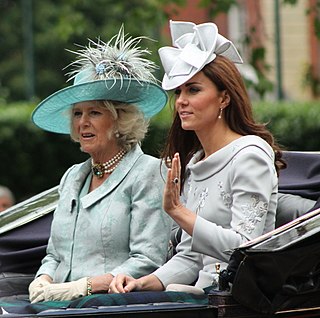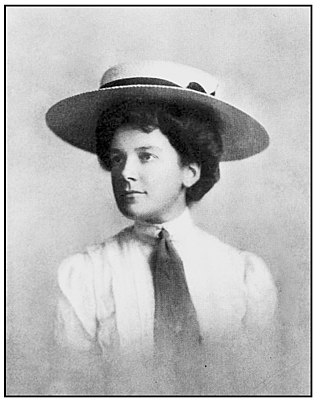
An apron is a garment that is worn over other clothing to cover the front of the body. The word comes from Old French napron meaning a small piece of cloth, however over time "a napron" became "an apron", through a linguistics process called rebracketing. It may have several purposes, typically as a functional accessory that protects clothes and skin from stains and marks. However, other types of aprons may be worn as a decoration, for hygienic reasons, as part of a uniform, or as protection from certain dangers such as acid, allergens or excessive heat. It can also be used at work stations to hold extra tools and pieces or protect from dust and unwanted materials.

A top hat is a tall, flat-crowned hat traditionally associated with formal wear in Western dress codes, meaning white tie, morning dress, or frock coat. Traditionally made of black silk or sometimes grey, the top hat emerged in Western fashion by the end of the 18th century. Although it declined by the time of the counterculture of the 1960s, it remains a formal fashion accessory. A collapsible variant of a top hat, developed in the 19th century, is known as an opera hat.

A slouch hat is a wide-brimmed felt or cloth hat most commonly worn as part of a military uniform, often, although not always, with a chinstrap. It has been worn by military personnel from many different nations including Australia, Ireland, the United Kingdom, Canada, India, New Zealand, Southern Rhodesia, France, the United States, the Confederate States, Germany and many others. Australia and New Zealand have had various models of slouch hat as standard issue headwear since the late Victorian period.

Bonnet has been used as the name for a wide variety of headgear for both sexes—more often female—from the Middle Ages to the present. As with "hat" and "cap", it is impossible to generalize as to the styles for which the word has been used, but there is for both sexes a tendency to use the word for pop styles in soft material and lacking a brim, or at least one all the way round, rather than just at the front. Yet the term has also been used, for example, for steel helmets. This was from Scotland, where the term has long been especially popular.
A pork pie hat is one of several different styles of hat that have been worn since the mid-19th century. The pork pie hat gained further popularity in the 20th century, being worn by famous actors and musicians. This style of hat features a flat crown that resembles a traditional pork pie, thus earning its name.

The tricorne or tricorn is a style of hat that was popular during the 18th century, falling out of style by 1800, though not called a "tricorne" until the mid-19th century. During the 18th century, hats of this general style were referred to as "cocked hats". At the peak of its popularity, the tricorne varied greatly in style and size, and was worn not only by the aristocracy, but also as common civilian dress, and as part of military and naval uniforms. Typically made from animal fiber, the more expensive being of beaver-hair felt and the less expensive of wool felt, the hat's most distinguishing characteristic was that three sides of the brim were turned up (cocked) and either pinned, laced, or buttoned in place to form a triangle around the crown. The style served two purposes: first, it allowed stylish gentlemen to show off the most current fashions of their wigs, and thus their social status; and secondly, the cocked hat, with its folded brim, was much smaller than other hats, and therefore could be more easily tucked under an arm when going inside a building, where social etiquette dictates that a gentleman should remove his hat. Tricornes with laced sides could have the laces loosened and the sides dropped down to provide better protection from the weather, sun, and rain.

In fashion, an accessory is an item used to contribute, in a secondary manner, to an individual's outfit. Accessories are often chosen to complete an outfit and complement the wearer's look. They have the capacity to further express an individual's identity and personality. Accessories come in different shapes, sizes, hues, etc. The term came into use in the 20th century.

The lobster-tailed pot helmet, also known as the zischägge, horseman's pot and harquebusier's pot, was a type of post-Renaissance combat helmet. It became popular in Europe, especially for cavalry and officers, from c. 1600; it was derived from an Ottoman Turkish helmet type. The helmet gradually fell out of use in most of Europe in the late 17th century; however, the Austrian heavy cavalry retained it for some campaigns as late as the 1780s.

Bands are a form of formal neckwear, worn by some clergy and lawyers, and with some forms of academic dress. They take the form of two oblong pieces of cloth, usually though not invariably white, which are tied to the neck. When worn by clergy, they typically are attached to a clerical collar. The word bands is usually plural because they require two similar parts and did not come as one piece of cloth. Those worn by clergy are often called preaching bands or Geneva bands; those worn by lawyers are called barrister's bands or, more usually in Ireland and Canada, tabs.

A bergère hat is a flat-brimmed straw hat with a shallow crown, usually trimmed with ribbon and flowers. It could be worn in various ways with the brim folded back or turned up or down at whim. It is also sometimes called a milkmaid hat. It was widely worn in the mid-18th century, and versions may be seen in many British and French paintings of the period, such as The Swing by Fragonard, and in portraits by Thomas Gainsborough and Johann Zoffany, amongst others. It has been suggested that the hat was named after Madame Bergeret, who is holding a shepherdess-style hat in a Boucher portrait painted c.1766.
The Medieval period in England is usually classified as the time between the fall of the Roman Empire to the beginning of the Renaissance, roughly the years AD 410–1485. For various peoples living in England, the Anglo-Saxons, Anglo-Danes, Normans and Britons, clothing in the medieval era differed widely for men and women as well as for different classes in the social hierarchy. The general styles of Early medieval European dress were shared in England. In the later part of the period, men's clothing changed much more rapidly than women's styles. Clothes were very expensive and both the men and women of lower social classes continued also divided social classes by regulating the colors and styles these various ranks were permitted to wear. In the early Middle Ages, clothing was typically simple and, particularly in the case of lower-class peoples, served only basic utilitarian functions such as modesty and protection from the elements. As time went on the advent of more advanced textile techniques and increased international relations, clothing gradually got more and more intricate and elegant, even with those under the wealthy classes, up into the renaissance.

A picture hat or Gainsborough hat is an elaborate woman's hat with a wide brim. It has been suggested that the name may be derived from the way the broad brim frames the face to create a "picture".

Cecil Willett Cunnington was an English medical doctor and collector, writer and historian on costume and fashion. When he died The Times called him the Leading Authority on English Costume. He and his wife Phillis Emily Cunnington (1887–1974) worked together not only in their medical practice but also on their collection and writing. In 1947 the Cunningtons' extensive costume collection was acquired by the Manchester City Art Gallery and the Gallery of Costume at Platt Hall was opened.

A sailor hat is a brimmed straw hat similar to those historically worn by nineteenth century sailors before the sailor cap became standard. It is very close in appearance to the masculine boater, although "sailors" as worn by women and children have their own distinct design, typically flat-crowned, wide-brimmed and with a dark ribbon band extending into streamers hanging off the brim. Such hats could also be made in felt as an alternative to straw.

A Breton is a woman's hat with a round crown and a deep brim that is turned upwards all the way round, exposing the face. Sometimes the hat has a domed crown. Typically it is worn tilted to the back of the head.

A mushroom hat is a millinery style in which the brim of the hat tilts downwards, resembling the shape of a mushroom. It is a style that first emerged in the 1870s and 1880s, when it was usually made of straw. It became fashionable again from around 1907 to the late 1920s; these versions featured a distinctly downturned brim although the size and shape of the crown varied according to prevailing fashions.

The Chapeau à la Paméla, Pamela hat or Pamela bonnet described a type of straw hat or bonnet popular during the 1790s and into the first three quarters of the 19th century. It was named after the heroine of Samuel Richardson's 1741 novel Pamela; or, Virtue Rewarded. While Pamela hats and bonnets underwent a variety of changes in shape and form, they were always made from straw. The mid-19th-century version of the Pamela hat was a smaller version of an early 19th-century wide-brimmed style called the gipsy hat.
The shovel hat was a style of hat formerly associated with the Anglican clergy, particularly archdeacons and bishops.
Phillis Emily Cunnington was an English medical doctor and collector, writer and historian on costume and fashion. She and her husband Cecil Willett Cunnington (1878–1961) worked together not only in their medical practice but also on their collection and writing. In 1947 the Cunningtons' extensive costume collection was acquired by the Manchester City Art Gallery and the Gallery of Costume at Platt Hall was opened.
















